stop start CITROEN DS3 2018 Handbook (in English)
[x] Cancel search | Manufacturer: CITROEN, Model Year: 2018, Model line: DS3, Model: CITROEN DS3 2018Pages: 248, PDF Size: 8.79 MB
Page 133 of 248
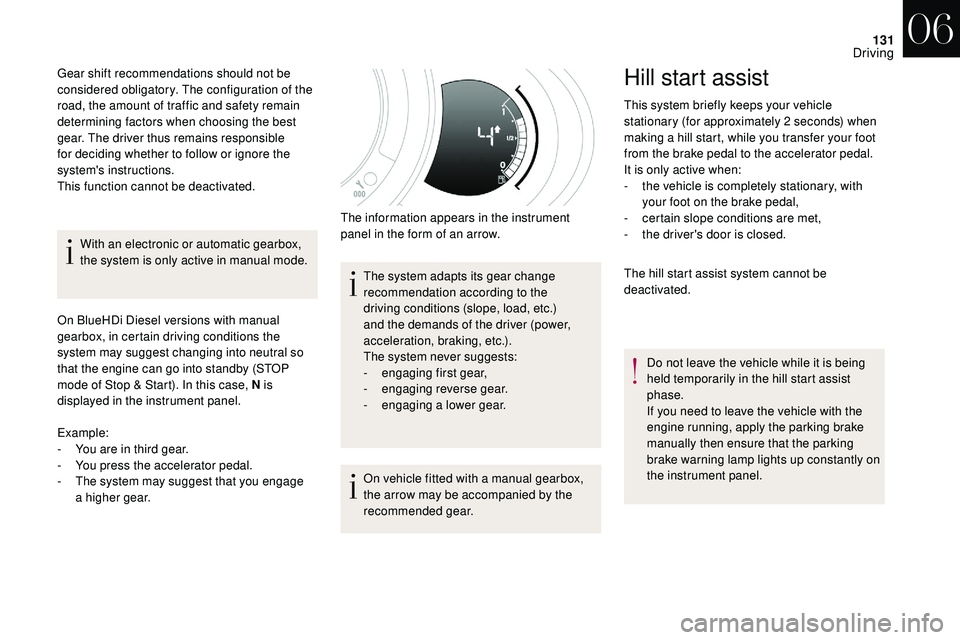
131
With an electronic or automatic gearbox,
the system is only active in manual mode.
On BlueHDi Diesel versions with manual
gearbox, in certain driving conditions the
system may suggest changing into neutral so
that the engine can go into standby (STOP
mode of Stop & Start). In this case, N is
displayed in the instrument panel.
Example:
-
Y
ou are in third gear.
-
Y
ou press the accelerator pedal.
-
T
he system may suggest that you engage
a
higher gear. The system adapts its gear change
recommendation according to the
driving conditions (slope, load, etc.)
and the demands of the driver (power,
acceleration, braking, etc.).
The system never suggests:
-
e
ngaging first gear,
-
enga
ging reverse gear.
-
enga
ging a
lower gear.
On vehicle fitted with a
manual gearbox,
the arrow may be accompanied by the
recommended gear.
Gear shift recommendations should not be
considered obligatory. The configuration of the
road, the amount of traffic and safety remain
determining factors when choosing the best
gear. The driver thus remains responsible
for deciding whether to follow or ignore the
system's instructions.
This function cannot be deactivated.
The information appears in the instrument
panel in the form of an arrow.
Hill start assist
This system briefly keeps your vehicle
stationary (for approximately 2 seconds) when
making a
hill start, while you transfer your foot
from the brake pedal to the accelerator pedal.
It is only active when:
-
t
he vehicle is completely stationary, with
your foot on the brake pedal,
-
c
ertain slope conditions are met,
-
t
he driver's door is closed.
The hill start assist system cannot be
deactivated.
Do not leave the vehicle while it is being
held temporarily in the hill start assist
phase.
If you need to leave the vehicle with the
engine running, apply the parking brake
manually then ensure that the parking
brake warning lamp lights up constantly on
the instrument panel.
06
Driving
Page 134 of 248
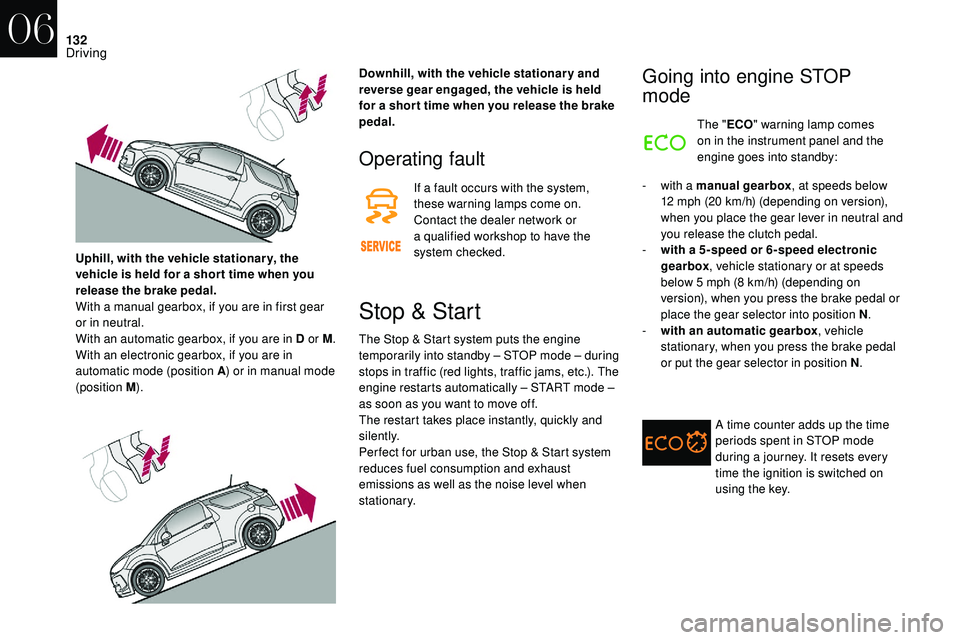
132
Operating fault
If a fault occurs with the system,
t hese warning lamps come on.
Contact the dealer network or
a
qualified workshop to have the
system checked.
Stop & Start
The Stop & Start system puts the engine
temporarily into standby – STOP mode – during
stops in traffic (red lights, traffic jams, etc.). The
engine restarts automatically – START mode –
as soon as you want to move off.
The restart takes place instantly, quickly and
silently.
Per fect for urban use, the Stop & Start system
reduces fuel consumption and exhaust
emissions as well as the noise level when
stationary.
Going into engine STOP
mode
The " ECO" warning lamp comes
on in the instrument panel and the
engine goes into standby:
-
w
ith a
manual gearbox , at speeds below
12
mph (20 km/h) (depending on version),
when you place the gear lever in neutral and
you release the clutch pedal.
-
w
ith a
5-speed or 6-speed electronic
gearbox , vehicle stationary or at speeds
below 5
mph (8 km/h) (depending on
version), when you press the brake pedal or
place the gear selector into position N .
-
w
ith an automatic gearbox , vehicle
stationary, when you press the brake pedal
or put the gear selector in position N .
A time counter adds up the time
periods spent in STOP mode
during a
journey. It resets every
time the ignition is switched on
using the key.
Uphill, with the vehicle stationar y, the
vehicle is held for a shor t time when you
release the brake pedal.
With a
manual gearbox, if you are in first gear
or in neutral.
With an automatic gearbox, if you are in D or M .
With an electronic gearbox, if you are in
automatic mode (position A ) or in manual mode
(position M ). Downhill, with the vehicle stationary and
reverse gear engaged, the vehicle is held
for a
shor t time when you release the brake
pedal.
06
Driving
Page 135 of 248
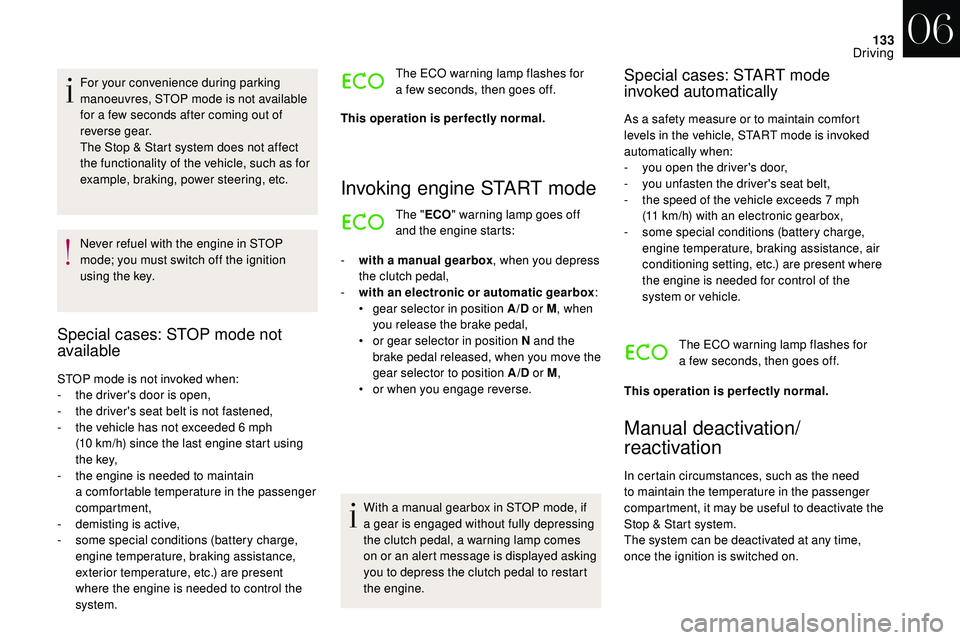
133
For your convenience during parking
manoeuvres, STOP mode is not available
for a few seconds after coming out of
reverse gear.
The Stop & Start system does not affect
the functionality of the vehicle, such as for
example, braking, power steering, etc.
Never refuel with the engine in STOP
mode; you must switch off the ignition
using the key.
Special cases: STOP mode not
available
STOP mode is not invoked when:
- t he driver's door is open,
-
t
he driver's seat belt is not fastened,
-
t
he vehicle has not exceeded 6 mph
(10
km/h) since the last engine start using
t h e key,
-
t
he engine is needed to maintain
a
comfortable temperature in the passenger
compartment,
-
d
emisting is active,
-
s
ome special conditions (battery charge,
engine temperature, braking assistance,
exterior temperature, etc.) are present
where the engine is needed to control the
system. The ECO warning lamp flashes for
a
few seconds, then goes off.
This operation is perfectly normal.
Invoking engine START mode
The " ECO" warning lamp goes off
and the engine starts:
-
w
ith a
manual gearbox , when you depress
the clutch pedal,
-
w
ith an electronic or automatic gearbox :
•
g
ear selector in position A/D or M, when
you release the brake pedal,
•
o
r gear selector in position N and the
brake pedal released, when you move the
gear selector to position A/D or M,
•
o
r when you engage reverse.
With a
manual gearbox in STOP mode, if
a
gear is engaged without fully depressing
the clutch pedal, a warning lamp comes
on or an alert message is displayed asking
you to depress the clutch pedal to restart
the engine.
Special cases: START mode
invoked automatically
As a safety measure or to maintain comfort
l evels in the vehicle, START mode is invoked
automatically when:
-
y
ou open the driver's door,
-
y
ou unfasten the driver's seat belt,
-
t
he speed of the vehicle exceeds 7 mph
(11
km/h) with an electronic gearbox,
-
s
ome special conditions (battery charge,
engine temperature, braking assistance, air
conditioning setting, etc.) are present where
the engine is needed for control of the
system or vehicle.
The ECO warning lamp flashes for
a
few seconds, then goes off.
This operation is perfectly normal.
Manual deactivation/
reactivation
In certain circumstances, such as the need
to maintain the temperature in the passenger
compartment, it may be useful to deactivate the
Stop & Start system.
The system can be deactivated at any time,
once the ignition is switched on.
06
Driving
Page 136 of 248
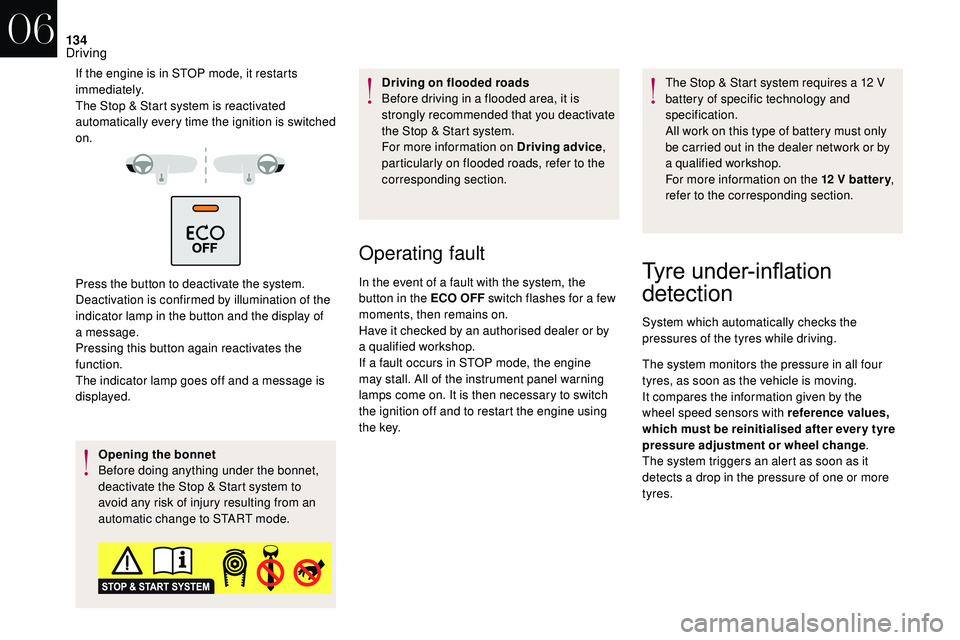
134
If the engine is in STOP mode, it restarts
immediately.
The Stop & Start system is reactivated
automatically every time the ignition is switched
on.
Press the button to deactivate the system.
Deactivation is confirmed by illumination of the
indicator lamp in the button and the display of
a
message.
Pressing this button again reactivates the
function.
The indicator lamp goes off and a
message is
displayed.
Opening the bonnet
Before doing anything under the bonnet,
deactivate the Stop & Start system to
avoid any risk of injury resulting from an
automatic change to START mode. Driving on flooded roads
Before driving in a
flooded area, it is
strongly recommended that you deactivate
the Stop & Start system.
For more information on Driving advice ,
particularly on flooded roads, refer to the
corresponding section.
Operating fault
In the event of a fault with the system, the
b utton in the ECO OFF switch flashes for a few
moments, then remains on.
Have it checked by an authorised dealer or by
a
qualified workshop.
If a
fault occurs in STOP mode, the engine
may stall. All of the instrument panel warning
lamps come on. It is then necessary to switch
the ignition off and to restart the engine using
t h e key. The Stop & Start system requires a
12 V
battery of specific technology and
specification.
All work on this type of battery must only
be carried out in the dealer network or by
a
qualified workshop.
For more information on the 12 V batter y
,
refer to the corresponding section.Tyre under-inflation
d
etection
System which automatically checks the
pressures of the tyres while driving.
The system monitors the pressure in all four
tyres, as soon as the vehicle is moving.
It compares the information given by the
wheel speed sensors with reference values,
which must be reinitialised after ever y tyre
pressure adjustment or wheel change .
The system triggers an alert as soon as it
detects a
drop in the pressure of one or more
tyres.
06
Driving
Page 139 of 248

137
The programmed speed can be exceeded
temporarily by pressing the accelerator firmly.
To return to the set speed, simply slow down to
a
speed below the programmed speed.
The set speed remains in the system memory
when the ignition is switched off.
The speed limiter cannot, in any circumstances,
replace the need to obser ve speed limits, nor can it
replace the need for vigilance on the part of the driver.
Steering mounted controls
1. Speed limiter mode selection thumb
wheel.
2. Value decrease button.
3. Value increase button.
4. Button to start /stop the speed limiter.
Displays in the instrument panel
The programmed information is grouped
together in the instrument panel screen.
5.Speed limiter on/off indication.
6. Speed limiter mode selected.
7. Programmed speed value.
Programming
F Turn thumb wheel 1 to the "LIMIT" position:
the speed limiter mode is selected but is not
switched on (PAUSE).
You do not have to switch the speed limiter on
in order to set the speed.
F
Set the speed value by pressing button 2 or 3
(e.g. 55 mph (90 km/h)).
You can change the programmed speed further
using buttons 2
and 3:
- by + or - 1 mph (km/h) = short press,- by + or - 5 mph (km/h) = long press,- in steps of + or - 5 mph (km/h) = maintained
press.
F Switch the speed limiter on by pressing button 4 .
F Switch the speed limiter off by pressing button 4 : a
confirmation message appears on the screen (PAUSE).
F Switch the speed limiter back on by pressing button 4
again.
06
Driving
Page 150 of 248
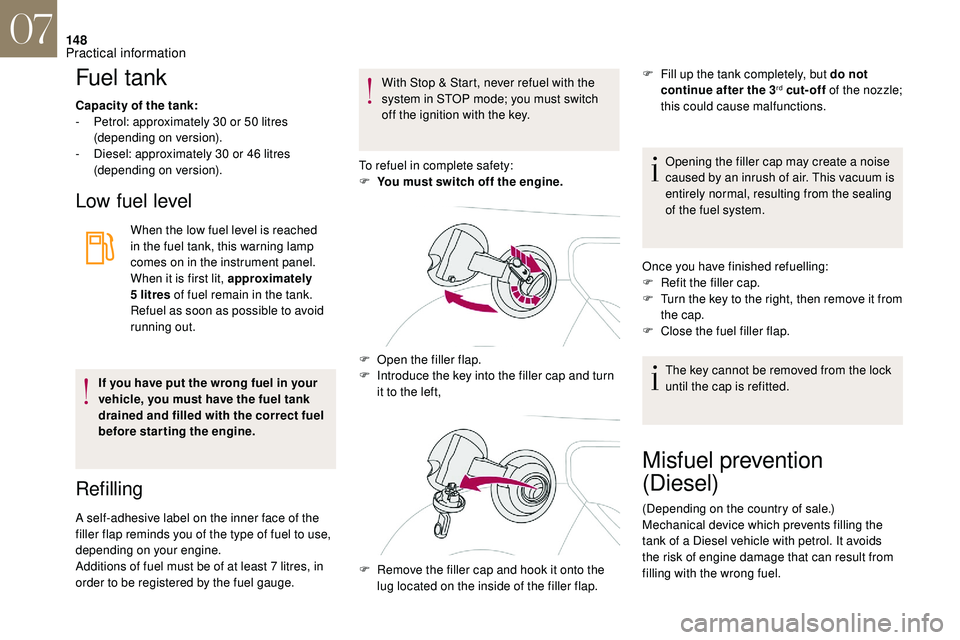
148
Fuel tank
Capacity of the tank:
- Pe trol: approximately 30 or 50 litres
(depending on version).
-
D
iesel: approximately 30 or 46 litres
(depending on version).
Low fuel level
When the low fuel level is reached
in the fuel tank, this warning lamp
comes on in the instrument panel.
When it is first lit, approximately
5
litres of fuel remain in the tank.
Refuel as soon as possible to avoid
running out.
If you have put the wrong fuel in your
vehicle, you must have the fuel tank
drained and filled with the correct fuel
before star ting the engine.
Refilling
A self-adhesive label on the inner face of the
filler flap reminds you of the type of fuel to use,
depending on your engine.
Additions of fuel must be of at least 7 litres, in
order to be registered by the fuel gauge. With Stop & Start, never refuel with the
system in STOP mode; you must switch
off the ignition with the key.
To refuel in complete safety:
F
Y
ou must switch off the engine.
F
O
pen the filler flap.
F
I
ntroduce the key into the filler cap and turn
it to the left, Opening the filler cap may create a noise
caused by an inrush of air. This vacuum is
entirely normal, resulting from the sealing
of the fuel system.
Once you have finished refuelling:
F
R
efit the filler cap.
F
T
urn the key to the right, then remove it from
the cap.
F
C
lose the fuel filler flap.
The key cannot be removed from the lock
until the cap is refitted.
F
R
emove the filler cap and hook it onto the
lug located on the inside of the filler flap. F
F
ill up the tank completely, but do not
continue after the 3
rd cut-off of the nozzle;
this could cause malfunctions.
Misfuel prevention
(Diesel)
(Depending on the country of sale.)
Mechanical device which prevents filling the
tank of a Diesel vehicle with petrol. It avoids
the risk of engine damage that can result from
filling with the wrong fuel.
07
Practical information
Page 155 of 248
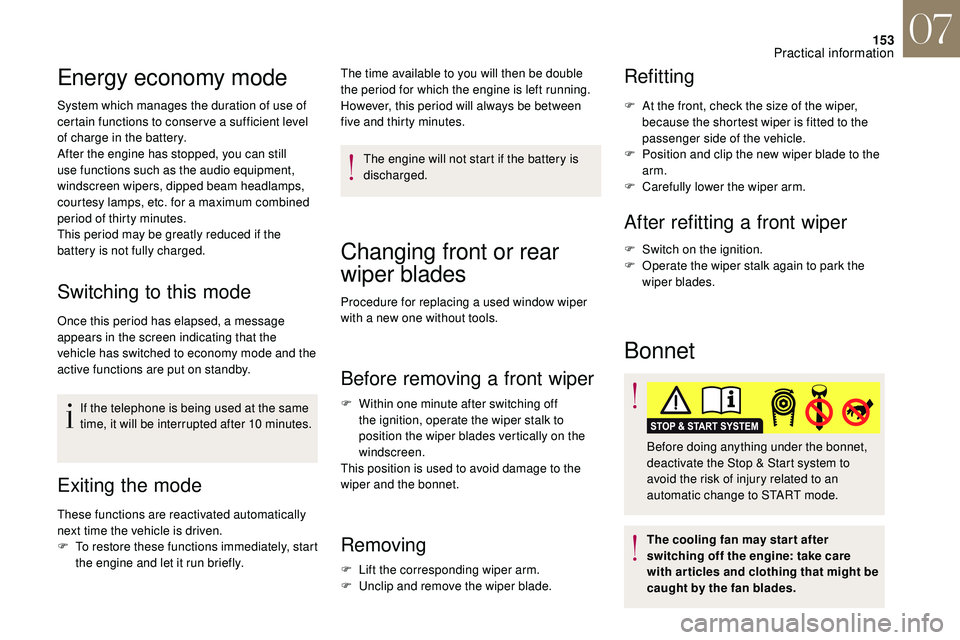
153
Energy economy mode
System which manages the duration of use of
certain functions to conser ve a sufficient level
of charge in the battery.
After the engine has stopped, you can still
use functions such as the audio equipment,
windscreen wipers, dipped beam headlamps,
courtesy lamps, etc. for a
maximum combined
period of thirty minutes.
This period may be greatly reduced if the
battery is not fully charged.
Switching to this mode
Once this period has elapsed, a message
appears in the screen indicating that the
vehicle has switched to economy mode and the
active functions are put on standby.
Exiting the mode
These functions are reactivated automatically
next time the vehicle is driven.
F
T
o restore these functions immediately, start
the engine and let it run briefly. If the telephone is being used at the same
time, it will be interrupted after 10
minutes.The engine will not start if the battery is
discharged.
The time available to you will then be double
the period for which the engine is left running.
However, this period will always be between
five and thirty minutes.
Changing front or rear
wiper blades
Procedure for replacing a used window wiper
w ith a new one without tools.
Before removing a front wiper
F Within one minute after switching off the ignition, operate the wiper stalk to
position the wiper blades vertically on the
windscreen.
This position is used to avoid damage to the
wiper and the bonnet.
Removing
F Lift the corresponding wiper arm.
F U nclip and remove the wiper blade.
Refitting
F At the front, check the size of the wiper, because the shortest wiper is fitted to the
passenger side of the vehicle.
F
P
osition and clip the new wiper blade to the
arm.
F
C
arefully lower the wiper arm.
After refitting a front wiper
F Switch on the ignition.
F O perate the wiper stalk again to park the
wiper blades.
Bonnet
Before doing anything under the bonnet,
deactivate the Stop & Start system to
avoid the risk of injury related to an
automatic change to START mode.
The cooling fan may star t after
switching off the engine: take care
with articles and clothing that might be
caught by the fan blades.
07
Practical information
Page 157 of 248
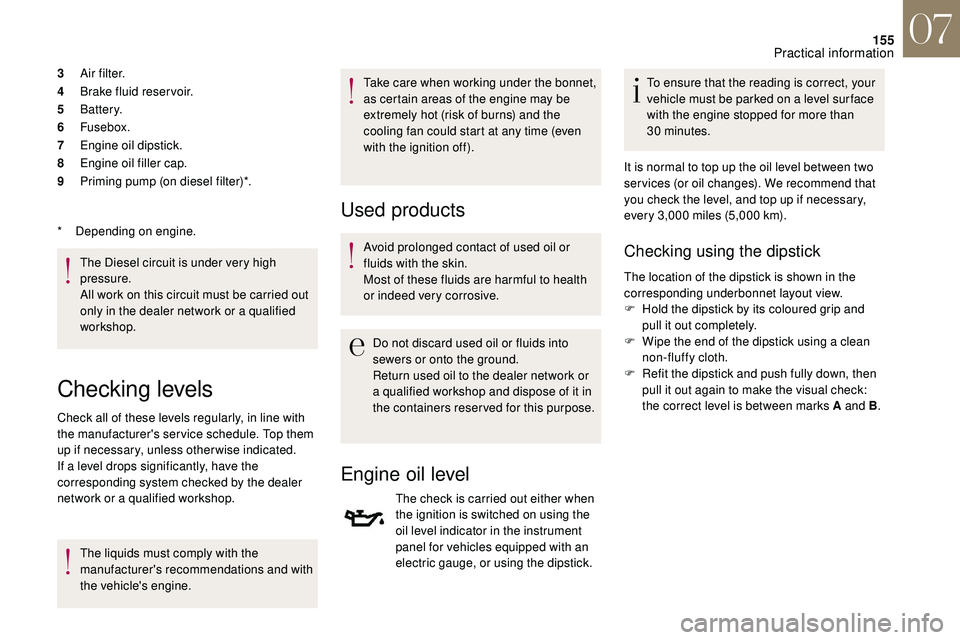
155
3A i r f i l t e r.
4 Brake fluid reser voir.
5 Battery.
6 Fusebox.
7 Engine oil dipstick.
8 Engine oil filler cap.
9 Priming pump (on diesel filter)*.
The Diesel circuit is under very high
pressure.
All work on this circuit must be carried out
only in the dealer network or a
qualified
workshop.
*
D
epending on engine.
Checking levels
Check all of these levels regularly, in line with
the manufacturer's service schedule. Top them
up if necessary, unless other wise indicated.
If a level drops significantly, have the
corresponding system checked by the dealer
network or a
qualified workshop.
The liquids must comply with the
manufacturer's recommendations and with
the vehicle's engine. Take care when working under the bonnet,
as certain areas of the engine may be
extremely hot (risk of burns) and the
cooling fan could start at any time (even
with the ignition off).
Used products
Avoid prolonged contact of used oil or
fluids with the skin.
Most of these fluids are harmful to health
or indeed very corrosive.
Do not discard used oil or fluids into
sewers or onto the ground.
Return used oil to the dealer network or
a
qualified workshop and dispose of it in
the containers reser ved for this purpose.
Engine oil level
The check is carried out either when
the ignition is switched on using the
oil level indicator in the instrument
panel for vehicles equipped with an
electric gauge, or using the dipstick. To ensure that the reading is correct, your
vehicle must be parked on a
level sur face
with the engine stopped for more than
30
minutes.
It is normal to top up the oil level between two
ser vices (or oil changes). We recommend that
you check the level, and top up if necessary,
every 3,000 miles (5,000 km).
Checking using the dipstick
The location of the dipstick is shown in the
corresponding underbonnet layout view.
F
H
old the dipstick by its coloured grip and
pull it out completely.
F
W
ipe the end of the dipstick using a clean
non-fluffy cloth.
F
R
efit the dipstick and push fully down, then
pull it out again to make the visual check:
the correct level is between marks A and B .
07
Practical information
Page 159 of 248
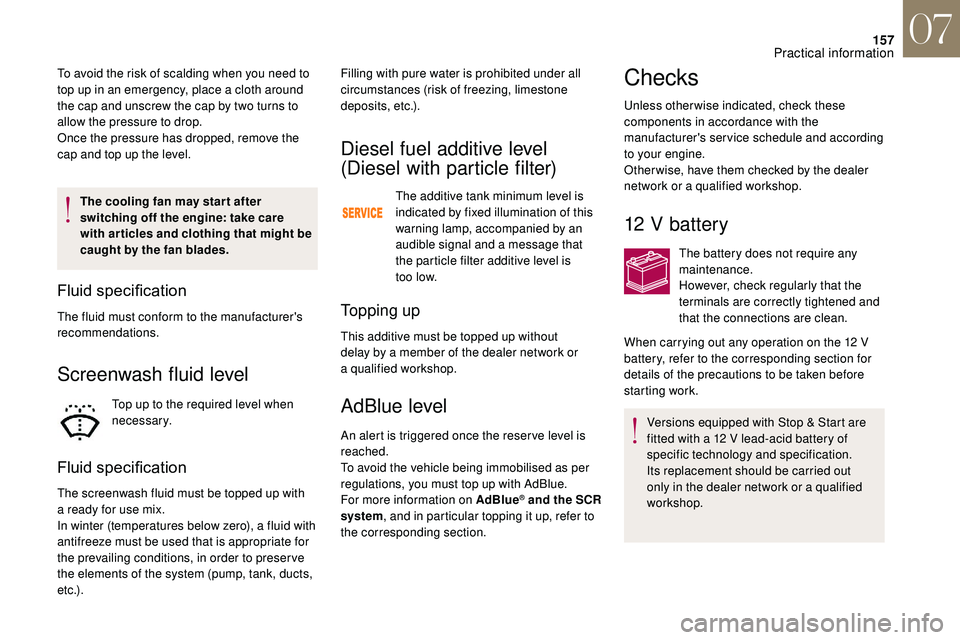
157
The cooling fan may star t after
switching off the engine: take care
with articles and clothing that might be
caught by the fan blades.
Fluid specification
The fluid must conform to the manufacturer's
recommendations.
Screenwash fluid level
Top up to the required level when
necessary.
Fluid specification
The screenwash fluid must be topped up with
a ready for use mix.
In winter (temperatures below zero), a fluid with
antifreeze must be used that is appropriate for
the prevailing conditions, in order to preser ve
the elements of the system (pump, tank, ducts,
e t c .) . To avoid the risk of scalding when you need to
top up in an emergency, place a cloth around
the cap and unscrew the cap by two turns to
allow the pressure to drop.
Once the pressure has dropped, remove the
cap and top up the level.
Diesel fuel additive level
(Diesel with particle filter)
The additive tank minimum level is
indicated by fixed illumination of this
warning lamp, accompanied by an
audible signal and a
message that
the particle filter additive level is
too low.
Topping up
This additive must be topped up without
delay by a member of the dealer network or
a
qualified workshop.
AdBlue level
An alert is triggered once the reser ve level is
reached.
To avoid the vehicle being immobilised as per
regulations, you must top up with AdBlue.
For more information on AdBlue
® and the SCR
system, and in particular topping it up, refer to
the corresponding section.
Checks
Unless otherwise indicated, check these
components in accordance with the
manufacturer's service schedule and according
to your engine.
Otherwise, have them checked by the dealer
network or a
qualified workshop.
12 V battery
The battery does not require any
maintenance.
However, check regularly that the
terminals are correctly tightened and
that the connections are clean.
Versions equipped with Stop & Start are
fitted with a
12 V lead-acid battery of
specific technology and specification.
Its replacement should be carried out
only in the dealer network or a
qualified
workshop.
When carrying out any operation on the 12
V
battery, refer to the corresponding section for
details of the precautions to be taken before
starting work.
Filling with pure water is prohibited under all
circumstances (risk of freezing, limestone
deposits, etc.).
07
Practical information
Page 164 of 248
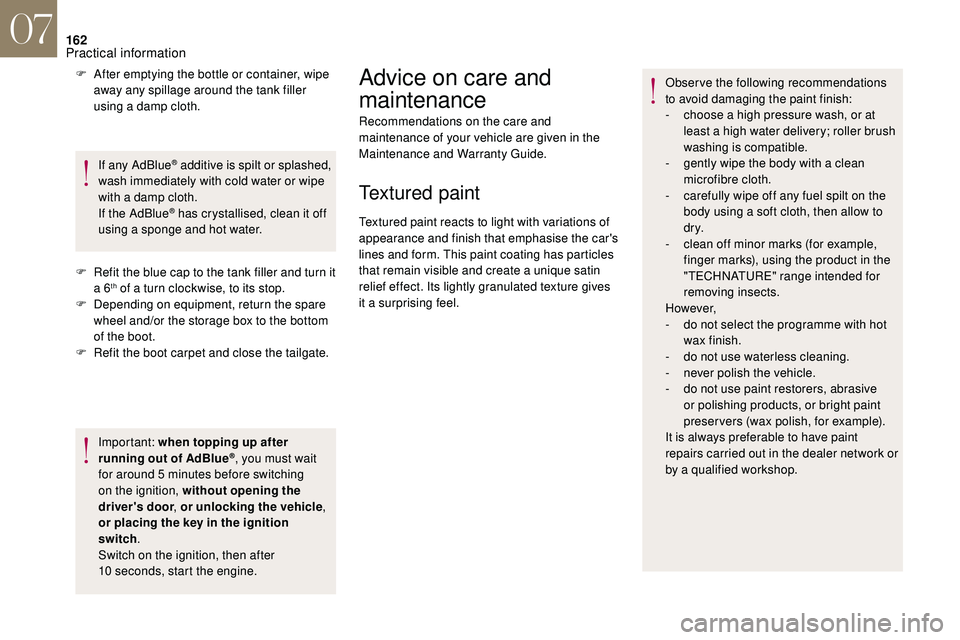
162
F After emptying the bottle or container, wipe away any spillage around the tank filler
using a
damp cloth.
If any AdBlue
® additive is spilt or splashed,
wash immediately with cold water or wipe
with a
damp cloth.
If the AdBlue
® has crystallised, clean it off
using a
sponge and hot water.
F
R
efit the blue cap to the tank filler and turn it
a
6
th of a turn clockwise, to its stop.
F
D
epending on equipment, return the spare
wheel and/or the storage box to the bottom
of the boot.
F
R
efit the boot carpet and close the tailgate.
Important: when topping up after
running out of AdBlue
®, you must wait
for around 5 minutes before switching
on the ignition, without opening the
driver's door , or unlocking the vehicle ,
or placing the key in the ignition
switch .
Switch on the ignition, then after
10
seconds, start the engine.
Advice on care and
maintenance
Recommendations on the care and
maintenance of your vehicle are given in the
Maintenance and Warranty Guide.
Textured paint
Textured paint reacts to light with variations of
appearance and finish that emphasise the car's
lines and form. This paint coating has particles
that remain visible and create a unique satin
relief effect. Its lightly granulated texture gives
it a
surprising feel. Observe the following recommendations
to avoid damaging the paint finish:
-
c
hoose a high pressure wash, or at
least a high water delivery; roller brush
washing is compatible.
-
g
ently wipe the body with a clean
microfibre cloth.
-
c
arefully wipe off any fuel spilt on the
body using a soft cloth, then allow to
d r y.
-
c
lean off minor marks (for example,
finger marks), using the product in the
"TECHNATURE" range intended for
removing insects.
H o w eve r,
-
d
o not select the programme with hot
wax finish.
-
d
o not use waterless cleaning.
-
n
ever polish the vehicle.
-
d
o not use paint restorers, abrasive
or polishing products, or bright paint
preser vers (wax polish, for example).
It is always preferable to have paint
repairs carried out in the dealer network or
by a
qualified workshop.
07
Practical information